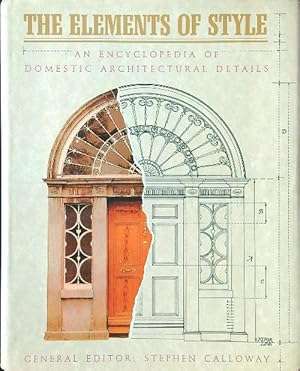
The Elements of Style: an Encyclopedia of Domestic Architectural Details
Check my rate
| Main centres: | 1-3 business days |
| Regional areas: | 3-4 business days |
| Remote areas: | 3-5 business days |

| Main centres: | 1-3 business days |
| Regional areas: | 3-4 business days |
| Remote areas: | 3-5 business days |
Today we are heirs to a legacy of fine building and to a continuing fascination with the details and stylistic elements which give our houses their character. In Britain, and in the United States too, that interest in old houses has become something of a national obsession. The desire to know and understand the history of our homes has never been stronger. We are, perhaps more than ever before,! aware of the crucial importance of our great architectural traditions and the central position they occupy in what we have come to call our heritage.
The heart of this concept of heritage lies our idealized image of the period house, which, great or small, ostentatious or plain, has come to epitomize so many of our notions of civilization. The study of the architectural evolution of the country house in England and the United States, and of urban and village building, has a long and distinguished history. But in recent years, academic interest in the planning, stylistic development and detailing of historic houses has increasingly become linked with the more passionate and practical enthusiasms of the conservation movement.
We have sought to create within the compass of a single volume a practical sourcebook for all those who care about our heritage of domestic architecture in Britain and the United States. The vast body of illustrative material that has been drawn together here includes specially commissioned photographs of houses, reproductions of engraved plates from the key architectural publications of each period, and drawings based on a wide variety of archival material, including old photographs and measured drawings (often of buildings now demolished), rare prints and builders' pattern books. The images used to illustrate each chapter have been selected by the individual authors, each of whom has made a particular study of his or her period. For each chapter the chief aim has been to show the development of standard forms but also to illustrate some of the influential high-points of architectural achievement and something of the variety that has always characterized domestic buildings.
Primarily, The Elements of Style, is intended as a visual and documentary resource for people concerned with the details of houses, whether as owners, conservators, architects, interior decorators or designers. For the student and the interested general reader the book can also be used as a way to trace the history of the British and American house. Between the practical approach and the academic there is no real division of interests: a chief desideratum in each case is sympathy for matters of detail, a belief in the importance of accuracy at the most meticulous level.
The overall plan of this book is a simple chronological one, period by period, style by style. The main chapters deal with what we may define as polite architecture: that is, buildings which aim, with whatever degree of success, at observing the architectural rules and at being fashionable, or in later periods buildings which conform to nationally prevalent types. Houses which fall outside this rather general definition -- modest country dwellings, traditional structural types in use over a long period, and distinct regional variations on standard forms -- are dealt with separately in chapters devoted to vernacular building.